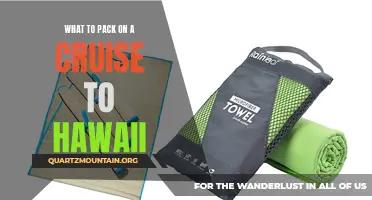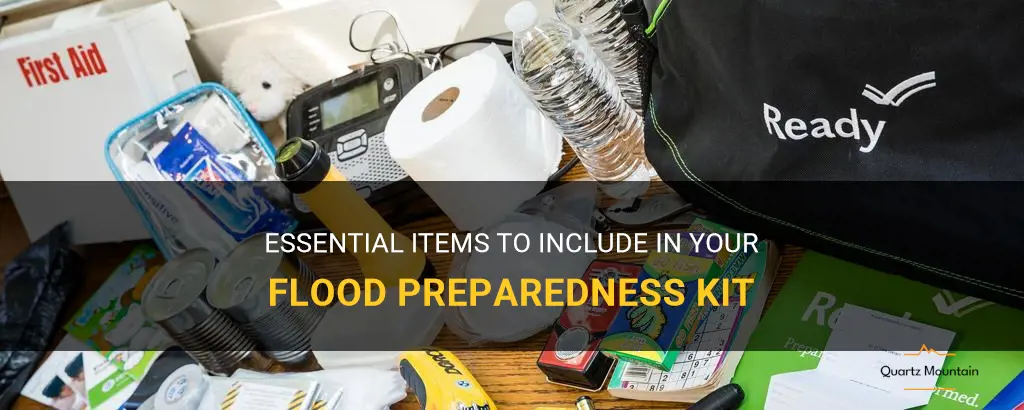
In the face of unpredictable weather patterns and rising sea levels, it is becoming increasingly important for individuals and communities to prepare for the possibility of flooding. With the potential to cause significant damage and displace entire populations, it is essential to have a well-stocked flood preparedness kit on hand. This comprehensive guide will highlight the key items you should include in your kit to ensure you are equipped to handle the challenges of a flood emergency. From basic essentials such as water and food supplies to important documents and emergency tools, this guide will empower you to take proactive steps towards staying safe and prepared in the face of a potential flood disaster.
| Characteristics | Values |
|---|---|
| Essential Items | - Flashlight with extra batteries - First aid kit - Non-perishable food - Bottled water - Prescription medications - Personal hygiene items - Extra clothing and blankets - Cash and important documents - Emergency contact information - Cellphone and charger |
| Preparation | - Waterproof bags or containers for important documents - Sandbags or flood barriers for protection - Emergency radio or weather alert radio - Extra pet supplies - Can opener - Tools and supplies for emergency repairs - Portable phone charger - Whistle or air horn for signaling |
| Clothing | - Raincoat or waterproof jacket - Rubber boots - Gloves - Extra socks - Hat or cap - Sunglasses - Change of clothes for each family member |
| Safety Equipment | - Life jackets - Safety helmets - Safety goggles - Dust masks - Fire extinguisher |
| Cleaning Supplies | - Disinfectant wipes - Rubber gloves - Mops and buckets - Brooms - Trash bags - Paper towels - Bleach or other cleaning agents - Sponges or scrub brushes |
| Food and Water | - Non-perishable food (canned goods, energy bars, etc.) - Bottled water (at least one gallon per person per day) - Water purification tablets - Manual can opener |
| Electronics and Communication | - Cellphone and charger - Portable phone charger - Emergency radio or weather alert radio - Whistle or air horn for signaling - Portable generator (if possible) - Walkie-talkies or two-way radios |
| Documents | - Important documents (identification, insurance policies, medical records, etc.) - Waterproof bags or containers to protect documents - Cash and credit cards - Emergency contact information |
| Sanitation and Hygiene | - Hand sanitizer - Soap - Toilet paper - Personal hygiene items (toothbrush, toothpaste, feminine hygiene products, etc.) - Trash bags - Baby wipes |
| First Aid Kit | - Bandages and adhesive tape - Antiseptic solution - Tweezers - Scissors - Pain relievers - Antibiotic ointment - Antihistamines - Thermometer - First aid manual |
What You'll Learn
- What essential items should be included in a flood preparedness kit?
- Are there any specific items that should be packed for infants or young children during a flood?
- What types of documents and personal identification should be included in a flood emergency bag?
- Are there any specific medications or medical supplies that should be packed for individuals with special health needs during a flood?
- How much water and non-perishable food should be packed per person for a flood emergency?

What essential items should be included in a flood preparedness kit?
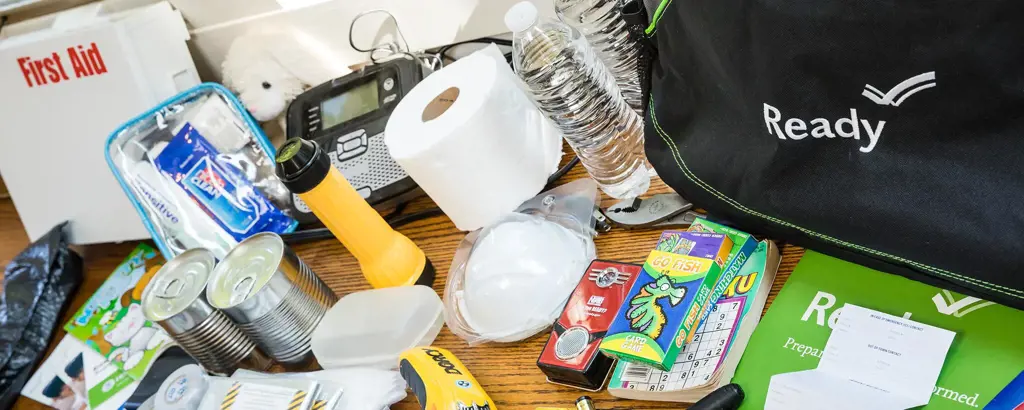
A flood can cause significant damage to your home and property, and can also be a threat to your safety and well-being. It is important to be prepared for such an event by having a flood preparedness kit ready. This kit should contain essential items that will help you and your family stay safe and comfortable during and after a flood. Here are some items that should be included in a flood preparedness kit:
Emergency Supplies:
- First aid kit: Make sure to include bandages, antiseptic ointment, pain relievers, and any necessary prescription medications.
- Flashlight and extra batteries: In case of a power outage, a flashlight will help you navigate in the dark.
- Personal hygiene items: Pack items such as soap, toothbrushes, toothpaste, and toilet paper.
- Whistle: This can be used to signal for help if you are trapped or in danger.
Food and Water:
- Non-perishable food: Include canned goods, energy bars, and dry food items that do not require cooking or refrigeration.
- Bottled water: Have at least one gallon of water per person per day for drinking and sanitation purposes.
Clothing and Bedding:
- Sturdy shoes and extra clothes: Pack a change of clothes for each family member, including underwear and socks. Also, include sturdy shoes or boots that can withstand wet conditions.
- Blankets and sleeping bags: These will provide warmth and comfort if you are unable to return to your home or if the heating system fails.
Important Documents:
- Copies of important documents: Make sure to include copies of identification cards, insurance policies, medical records, and any other important documents.
- Contact information: Have a list of emergency contact numbers, including the local authorities, relatives, and neighbors.
Tools and Supplies:
- Multi-purpose tool: A tool with various functions, such as a Swiss Army knife, can be helpful in a variety of situations.
- Duct tape: This versatile tool can be used for temporary repairs and sealing windows or doors.
Other Considerations:
- Cash: Keep a small amount of cash or traveler's checks on hand in case electronic payment systems are not available.
- Entertainment: Include items such as books, playing cards, or board games to help pass the time during a power outage or evacuation.
- Pet supplies: If you have pets, don't forget to include food, water, medication, and any other necessary supplies for their care.
It is essential to regularly update your flood preparedness kit and check expiration dates on food, water, and medication. Additionally, stay informed about flood warnings and evacuation orders in your area.
Remember, your safety should always come first during a flood. If you are instructed to evacuate, follow the advice of local authorities and ensure the safety of your family and yourself.
Essential Packing Guide for a 14 Day European River Cruise
You may want to see also

Are there any specific items that should be packed for infants or young children during a flood?

During a flood, it is essential to be prepared and have a well-stocked emergency kit that includes specific items for infants and young children. Infants and young children have unique needs and require special attention during emergency situations. Here are some items that should be packed for infants or young children during a flood:
- Diapers and Wipes: It is crucial to have an ample supply of diapers and wipes for infants and toddlers. During a flood, access to clean water and sanitation facilities may be limited, so having enough diapers and wipes is essential to maintaining proper hygiene.
- Formula and Baby Food: If your child is formula-fed or eating baby food, it is vital to have a sufficient supply on hand. Power outages or limited access to clean water can make it difficult to prepare formula or heat up baby food, so be sure to pack enough to last for several days.
- Bottles and Sippy Cups: Pack a sufficient number of bottles and sippy cups, along with any necessary cleaning supplies. These are necessary for feeding infants and young children, and having extras ensures that you can continue to provide nourishment even in a temporary shelter.
- Medications: If your child requires any medications, make sure to pack enough to last for several days. Keep them in their original packaging with clear instructions for dosage and administration. It is also a good idea to have a copy of their prescription, in case you need to refill the medication while away from home.
- Comfort Items: Floods can be traumatic for young children, so it is essential to provide them with comfort items. Pack their favorite stuffed animals, blankets, or toys to help ease their anxiety and provide a sense of familiarity during this challenging time.
- Clothing and Bedding: Pack several changes of clothing for your child, including pajamas, socks, and shoes. Floodwaters can be dirty and may damage existing clothing, so having extra sets will ensure their comfort and cleanliness. Additionally, bring a waterproof blanket or sleeping bag to provide a clean and comfortable sleeping surface if you are displaced from your home.
- Personal Hygiene Items: Just like adults, infants and young children need personal hygiene items such as soap, shampoo, and toothpaste. Pack these items in travel-sized containers to save space in your emergency kit.
- Entertainment: To keep your child occupied during the difficulties of a flood, include some age-appropriate entertainment items. Books, coloring supplies, and small toys can help distract them from the stressful situation and make the experience a little easier for them.
Remember to periodically check the expiration dates on items such as formula, baby food, and medications, and replace them as needed. It is also important to regularly review and update your emergency kit as your child's needs change and they grow older. By being prepared and packing these essential items, you can ensure the comfort and well-being of your infant or young child during a flood situation.
Essential Items to Include in Your Packing List for a Pigeon Forge Trip
You may want to see also

What types of documents and personal identification should be included in a flood emergency bag?
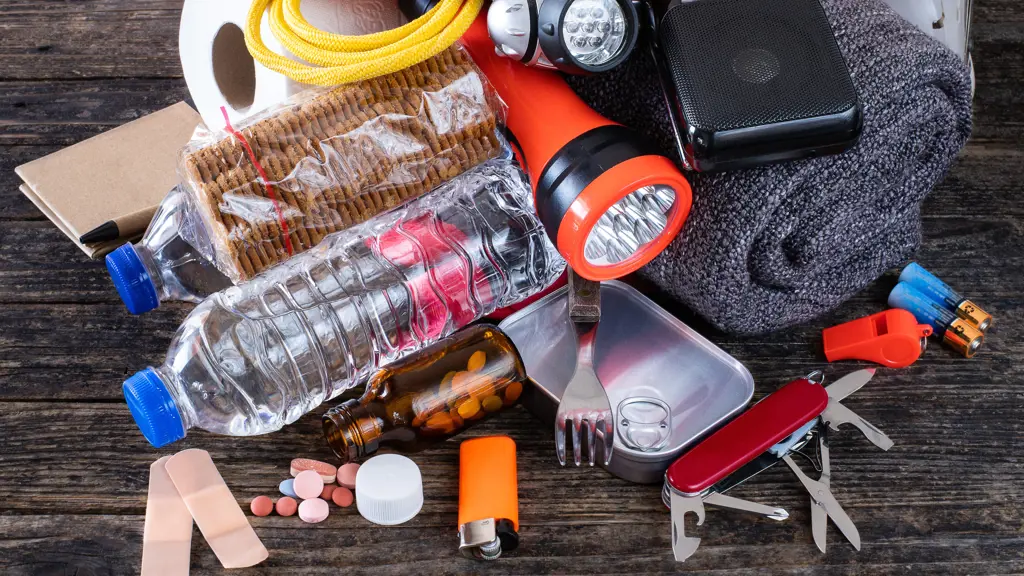
A flood emergency bag is an essential item to have on hand in case of a flood. It is important to include important documents and personal identification in this bag to ensure that you have access to them in case of an emergency. Here are some types of documents and personal identification that should be included in a flood emergency bag:
Identification Documents:
- Driver's license or identification card: This is important to have in case you need to prove your identity or access certain services during a flood emergency.
- Passport: If you have a passport, it is a good idea to include it in your emergency bag. This can be useful for identification purposes or for international travel if you need to evacuate.
- Social Security card: Your Social Security card contains your unique identification number, which can be important for accessing services or filing insurance claims after a flood.
Important Certificates and Records:
- Birth certificates: Make sure to include copies of birth certificates for yourself and your family members. These can be important for proving your identity or for obtaining government assistance after a flood.
- Marriage certificate: If you are married, include a copy of your marriage certificate. This can be important for accessing certain benefits or services during an emergency.
- Adoption papers: If you have adopted a child, include a copy of the adoption papers in your emergency bag.
- Will and testament: It is always a good idea to have a copy of your will and testament in case of an emergency.
- Property records: Include copies of property records, such as deeds or titles, in case you need to prove ownership or access certain services after a flood.
Financial and Insurance Documents:
- Bank account information: Include a list of your bank accounts and their corresponding account numbers.
- Insurance policies: Include copies of your insurance policies, including homeowners, renters, and flood insurance policies. These can be important for filing claims after a flood.
- Mortgage or lease documents: Include copies of your mortgage or lease documents, as these can be important for accessing assistance or services after a flood.
Medical and Health Documents:
- Health insurance cards: Make sure to include copies of your health insurance cards for yourself and your family members.
- Prescription information: If you or your family members take prescription medications, include a list of the medications and their dosages in your emergency bag.
- Medical records: If you have any important medical records, such as allergy information or chronic illness documentation, include copies of these in your emergency bag.
Miscellaneous Documents:
- Contact information: Include a list of emergency contacts, including family members, friends, and neighbors. Also include a list of important phone numbers, such as your insurance company and healthcare providers.
- Personal documents and photos: If you have any sentimental or irreplaceable personal documents or photos, consider including copies of these in your emergency bag.
It is important to keep these documents and personal identification in a secure and waterproof container within your flood emergency bag. Consider making duplicates of these documents and storing them in a separate location as well, such as a safe deposit box or with a trusted family member.
In conclusion, including important documents and personal identification in a flood emergency bag is crucial. By having these items readily available, you will be better prepared to navigate the aftermath of a flood and access necessary services or benefits. Remember to regularly update and review the contents of your emergency bag to ensure all information is current and accurate.
Essential Packing Tips for Hiking the West Highland Way
You may want to see also

Are there any specific medications or medical supplies that should be packed for individuals with special health needs during a flood?
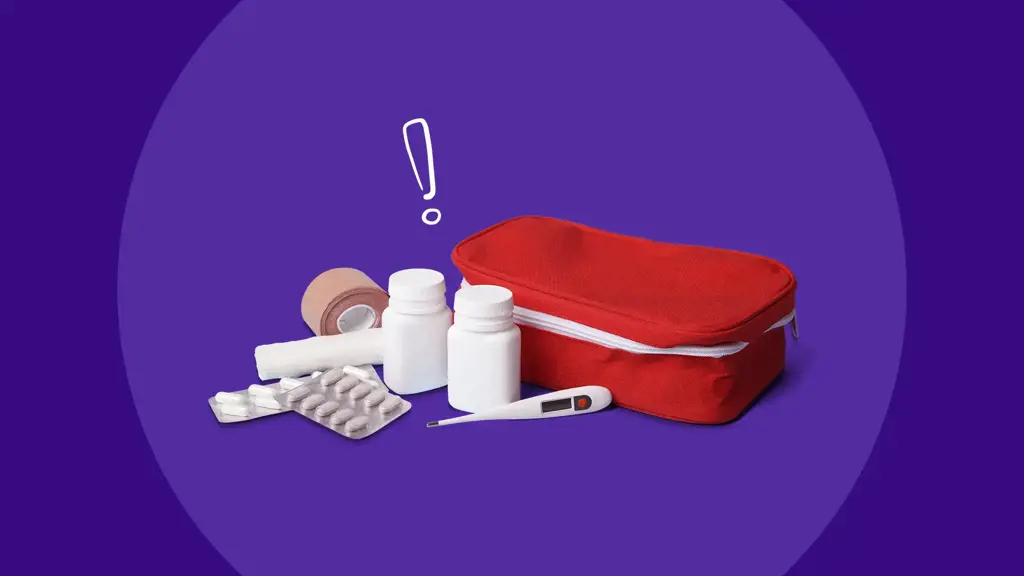
Floods can be incredibly damaging and disruptive, affecting individuals of all walks of life. However, for individuals with special health needs, floods can pose even greater challenges. It is important for these individuals to be prepared, including having the necessary medications and medical supplies on hand. In this article, we will discuss some specific medications and medical supplies that should be packed for individuals with special health needs during a flood.
Prescription Medications:
Individuals with special health needs often rely on prescription medications to manage their condition. It is crucial to pack an ample supply of these medications, as well as any necessary devices or equipment needed to administer the medication. Make sure to include enough medication to last for at least a week, as it may take time for normal supply chains to be restored after a flood.
Essential Medical Equipment:
For individuals who require medical equipment to manage their condition, it is important to have a portable version of this equipment ready to go in case of a flood. Examples of essential medical equipment include oxygen tanks, nebulizers, insulin pumps, and portable ventilators. It may be necessary to consult with a healthcare professional to ensure that the equipment is safely portable.
Extra Batteries and Power Banks:
During a flood, power outages are common. To ensure that essential medical equipment can still be used, it is important to have extra batteries and power banks available. This will allow individuals to continue using their medical equipment even when there is no access to electricity.
Non-Perishable Foods and Bottled Water:
In addition to medications and medical supplies, it is important to pack non-perishable foods and bottled water. These items can be critical during a flood when access to fresh food and clean water may be limited. Individuals with special health needs may require specific types of food or dietary considerations, so it is important to pack accordingly.
Medical Documents and Information:
Finally, it is crucial to have important medical documents and information readily available. This includes copies of prescriptions, medical records, and contact information for healthcare providers. In case of evacuation or separation, having these documents on hand can help ensure that individuals with special health needs receive the appropriate medical care.
In conclusion, individuals with special health needs should take extra precautions and prepare for floods by packing specific medications and medical supplies. This includes having an ample supply of prescription medications, portable medical equipment, extra batteries, non-perishable foods, and bottled water. It is also important to have important medical documents and information readily available. By taking these steps, individuals with special health needs can better navigate the challenges posed by floods and ensure their health and well-being.
The Essential Guide: What Clothes to Pack for Baby Vacation
You may want to see also

How much water and non-perishable food should be packed per person for a flood emergency?
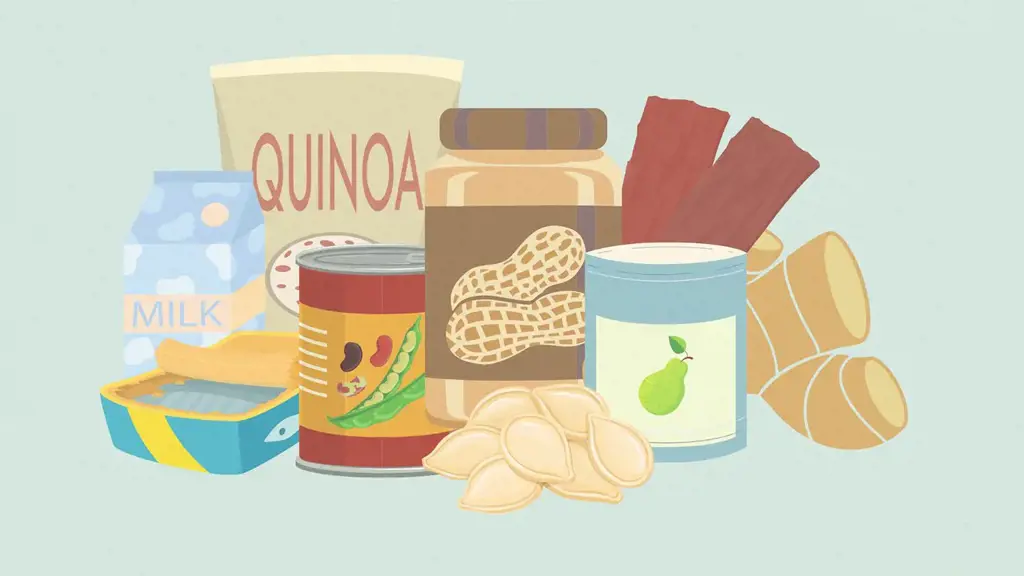
In flood emergencies, it is crucial to ensure that you have an adequate supply of water and non-perishable food for each person in your household. Floods can disrupt water supplies and access to grocery stores, so it is important to be prepared. In this article, we will discuss how much water and non-perishable food should be packed per person for a flood emergency.
Water is essential for survival, and it is important to have enough to last for at least three days. The general guideline is to pack one gallon of water per person per day. This includes both drinking water and water for basic hygiene needs. For a family of four, you should pack at least 12 gallons of water for a three-day emergency period. It is recommended to store water in clean, airtight containers such as plastic jugs or bottles. Remember to also include water for your pets if you have any.
When it comes to non-perishable food, it is best to choose items that do not require refrigeration, cooking, or added water. These foods should be easy to store and have a long shelf life. Some examples of non-perishable food items include:
- Canned goods: Choose canned fruits, vegetables, soups, and meat products that are high in nutrients and have a long shelf life. Be sure to pack a manual can opener as well.
- Dried goods: Include items like dried fruits, nuts, jerky, and granola bars. These foods are lightweight and provide a good source of energy.
- Ready-to-eat meals: There are various options available on the market, such as MREs (Meals Ready-to-Eat), which are specifically designed for emergency situations. These meals often come with a heating element and do not require any additional cooking or water.
- Nut butter: Peanut butter or other nut butters are an excellent source of protein and healthy fats. They can be stored for a long time and are easy to consume.
- Crackers and rice cakes: These items are great for snacking and can be paired with canned meats or spreads for a more filling meal.
It is recommended to have enough non-perishable food to last for at least three days. Plan for approximately 2,000 calories per person per day, but adjust according to individual needs and preferences. Remember to regularly check the expiration dates of your food items and rotate them out as needed to ensure freshness.
In addition to water and food, it is also essential to pack other emergency supplies such as a first aid kit, medications, flashlights, batteries, a battery-powered radio, blankets, a waterproof container for important documents, and a basic toolkit.
Preparing for a flood emergency should be a priority for every household. By packing an adequate supply of water and non-perishable food, you can ensure the well-being and safety of your family during such a challenging time. Stay informed about flood warnings and evacuation orders, and follow the instructions of local authorities to ensure your and your family's safety.
The Ultimate Guide on What to Pack for Glamping
You may want to see also
Frequently asked questions
When preparing for a flood, it is important to pack essential items that can help you during and after the flood. Some of the essential items to pack include bottled water, non-perishable food items, a first aid kit, extra clothing and blankets, flashlights with extra batteries, a portable radio, important documents and identification, hygiene products, and any necessary medications.
Yes, packing some tools and equipment can be helpful during and after a flood. It is recommended to pack tools such as a wrench, pliers, hammer, nails, and a utility knife. These tools can be useful for shutting off utilities, repairing any damages, and opening emergency supplies if needed.
When preparing for a flood, it is important to include items for your pets in your emergency kit. Pack enough food, water, and any necessary medications for your pets. Additionally, pack their collar with identification, a leash, portable pet carrier or cage, bedding, and familiar toys or blankets to help comfort them during the stressful situation of a flood.






